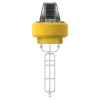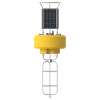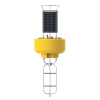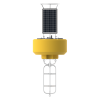NexSens CB-50 Data Buoy
Features
- Design accommodates X2-SDL data loggers and is compatible with many environmental sensors
- Cellular, Iridium satellite, and radio-to-shore telemetry options available
- Lightweight system can be deployed by a single person
- Expedited repair and warranty service
- Lifetime technical support
- More
The CB-50 Data Buoy is designed for quick deployment in emergency response situations including industrial spills and natural disasters. The buoy can be deployed from small boats, large vessels or even helicopters, making it the ideal choice for applications where water needs to be monitored at a moment’s notice. Compatible instruments include turbidity sensors, dissolved oxygen sensors, hydrocarbon sensors, fluorometers, multi-parameter sondes, pressure transducers, and more.
The buoy is constructed of an inner core of cross-linked polyethylene foam with a tough polyurea skin and stainless steel frame. The 5.5" ID center hole houses the X2-SDL data logging system, which includes integrated power supply and wireless antenna. A removable topside foam tower protects the electronics, supports solar marine lights, and offers a convenient lifting point via (3) 5/8" eyenuts. Optional accessories include instrument cages and mounting clamps to secure instruments to the platform.
The CB-50 Data Buoy is designed to accommodate NexSens X2-SDL submersible data loggers. Wireless telemetry options include cellular, Iridium satellite, and spread spectrum radio. The X2-SDL is configured with three sensor ports for connection to industry-standard digital interfaces including RS-485, RS-232 and SDI-12. Additional sensor inputs are available through the use of adapters. All sensor connections feature a double O-ring seal for a reliable waterproof connection.
- Hull Outer Diameter: 20.0” (50.8cm)
- Hull Height: 12.0” (30.48cm)
- Center Hole Inner Diameter: 5.5” (13.97cm)
- Tower Height: 10.0" (25.4cm)
- Weight: 35 lb (16kg)
- Net Buoyancy: 50 lb (23kg)
- Hull Material: Cross-linked polyethylene foam with polyurea coating & stainless steel deck
- Hardware Material: 316 stainless steel
- Mooring Attachments: 1x 3/4” eyenut
In The News
IoT for Smarter Aquaculture
With aquaculture booming, IoT may be the future of the market. Fish have been farmed for millennia but only recently has the industry achieved such a vast scale. As overexploitation and climate change threaten wild fish stocks, aquaculture is increasingly framed as an alternative that can provide a low-carbon, healthy protein source. But, as the global population grows, the industry has the monumental task of meeting the increasing demand for seafood. In order to provide higher yields economically and sustainably, it is turning to the Internet of Things, or IoT. IoT refers to technology that pulls data from smart sensors to the Cloud and crunches it using analytic software tools, including artificial intelligence (AI), to monitor and improve efficiency or productivity.
Read MoreLow Tech, Low Cost Buoys Coming to Maine’s Shellfish Farmers
What might the Maine Aquaculture Innovation Center’ s (MAIC) buoy offer that other governments and university monitoring equipment lack? The center doesn’t have MicroCAT recorders or autonomous acoustic sensing gliders. It’s not deploying hundred-thousand-dollar oceanographic mooring lines gathering massive amounts of data. So what can MAIC’s three-foot prototype buoy offer that others can’t? It’s easy to clean and costs very little. “One of the big issues for putting anything in the water is biofouling,” said Josh Girgis, an engineer at MAIC based at the University of Maine’s Darling Marine Center (DMC). “If you put a sensor in, you can only expect it to work until something starts growing on it.
Read MoreCombating Water Insecurity in Saskatchewan with Real-Time Data
The prairies of Saskatchewan can be described as one of the least water-secure parts of Canada, making water quality monitoring essential for informed resource management in a region already facing water insecurity. While natural physical properties worsen some of the poor water quality conditions in the region, others are connected to land use. Having grown up spending summers on the shores of Lake Huron, Helen Baulch, an associate professor at the School of Environment and Sustainability at the University of Saskatchewan , has always been dedicated to the protection of water resources. Looking back fondly at her childhood playing along the shore, Baulch also recalls the invasion of quagga mussels during her teenage years and watching the lake change as a result.
Read More


























